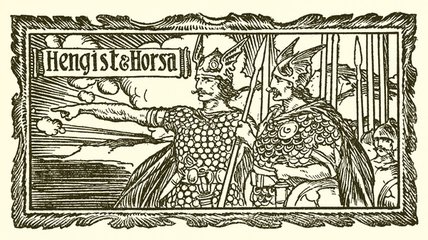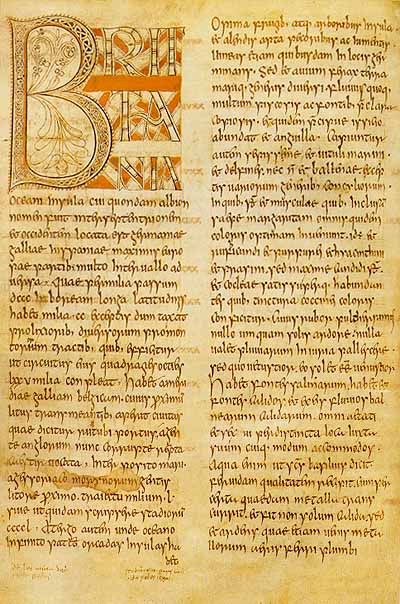|
Hengist And Horsa
Hengist (, ) and Horsa are legendary Germanic peoples, Germanic brothers who according to later English legends and ethnogenesis theories led the Angles (tribe), Angles, Saxons and Jutes, the progenitor groups of modern English people, in their Anglo-Saxon settlement of Britain, supposed invasion of Great Britain in the 5th century. Tradition lists Hengist as the first of the Jutish kings, or alternatively as the founder itself, of the Kingdom of Kent. Modern scholarly consensus regards Hengist and Horsa as mythical figures, given their alliteration, alliterative animal names, the seemingly constructed nature of their genealogy, and the unknowable quality of Bede's sources.Halsall (2013:60-62). Their later detailed representation in texts such as the Anglo-Saxon Chronicle says more about ninth-century attitudes to the past than about the time in which they are said to have existed.Yorke (1993).Harland (2021:32). According to early sources, Hengist and Horsa arrived in Britain ... [...More Info...] [...Related Items...] OR: [Wikipedia] [Google] [Baidu] |
Treachery Of The Long Knives
{{disambiguation ...
Treachery is the betrayal or violation of trust. It may refer to: * Treachery (law), an offence in several countries, related to treason * Treachery (''Revenge''), the eighth episode of the American television series ''Revenge'' * ''Treachery'' (film), a film written and directed by Travis Romero and starring Michael Biehn *'' The Dark Tower: Treachery'', the Stephen King comic book series *An Old Norse word for Sköll, a wolf in Norse mythology See also * Treacherous (other) *Treason Treason is the crime of attacking a state (polity), state authority to which one owes allegiance. This typically includes acts such as participating in a war against one's native country, attempting to Coup d'état, overthrow its government, spy ... [...More Info...] [...Related Items...] OR: [Wikipedia] [Google] [Baidu] |
Wictgils
A number of royal genealogies of the Heptarchy, Anglo-Saxon kingdoms, collectively referred to as the Anglo-Saxon royal genealogies, have been preserved in a manuscript tradition based in the 8th to 10th centuries. The genealogies trace the succession of the early Anglo-Saxon kings, back to the semi-legendary kings of the Anglo-Saxon settlement of Britain, notably named as Hengist and Horsa in Bede's ''Ecclesiastical History of the English People, Historia ecclesiastica gentis Anglorum'', and further to legendary kings and heroes of the pre-migration period, usually including an Origin myth, eponymous ancestor of the respective Sippe, lineage and converging on Odin, Woden. In their fully elaborated forms as preserved in the ''Anglo-Saxon Chronicle, Anglo-Saxon Chronicles'' and the ''Textus Roffensis'', they continue the pedigrees back to the biblical patriarchs Noah and Adam. They also served as the basis for pedigrees that would be developed in 13th century Iceland for the Scandi ... [...More Info...] [...Related Items...] OR: [Wikipedia] [Google] [Baidu] |
Ecclesiastical History Of The English People
The ''Ecclesiastical History of the English People'' (), written by Bede in about AD 731, is a history of the Christian Churches in England, and of England generally; its main focus is on the growth of Christianity. It was composed in Latin, and is believed to have been completed in 731 when Bede was approximately 59 years old. It is considered one of the most important original references on Anglo-Saxon history, and according to some scholars has played a key role in the development of an English national identity. Overview The , or ''An Ecclesiastical History of the English People'', is Bede's best-known work, completed in about 731. The first of the five books begins with some geographical background and then sketches the history of England, beginning with Julius Caesar's invasion in 55 BC. A brief account of Christianity in Roman Britain, including the martyrdom of St Alban, is followed by the story of Augustine's mission to England in 597, which brought Christianity to the ... [...More Info...] [...Related Items...] OR: [Wikipedia] [Google] [Baidu] |
Bear
Bears are carnivoran mammals of the family (biology), family Ursidae (). They are classified as caniforms, or doglike carnivorans. Although only eight species of bears are extant, they are widespread, appearing in a wide variety of habitats throughout most of the Northern Hemisphere and partially in the Southern Hemisphere. Bears are found on the continents of North America, South America, and Eurasia. Common characteristics of modern bears include large bodies with stocky legs, long snouts, small rounded ears, shaggy hair, plantigrade paws with five nonretractile claws, and short tails. While the polar bear is mostly carnivorous, and the giant panda is mostly herbivorous, the remaining six species are omnivorous with varying diets. With the exception of courtship display, courting individuals and mothers with their young, bears are typically solitary animals. They may be diurnality, diurnal or nocturnal and have an excellent sense of smell. Despite their heavy build and awk ... [...More Info...] [...Related Items...] OR: [Wikipedia] [Google] [Baidu] |
French Language
French ( or ) is a Romance languages, Romance language of the Indo-European languages, Indo-European family. Like all other Romance languages, it descended from the Vulgar Latin of the Roman Empire. French evolved from Northern Old Gallo-Romance, a descendant of the Latin spoken in Northern Gaul. Its closest relatives are the other langues d'oïl—languages historically spoken in northern France and in southern Belgium, which French (Francien language, Francien) largely supplanted. It was also substratum (linguistics), influenced by native Celtic languages of Northern Roman Gaul and by the Germanic languages, Germanic Frankish language of the post-Roman Franks, Frankish invaders. As a result of French and Belgian colonialism from the 16th century onward, it was introduced to new territories in the Americas, Africa, and Asia, and numerous French-based creole languages, most notably Haitian Creole, were established. A French-speaking person or nation may be referred to as Fra ... [...More Info...] [...Related Items...] OR: [Wikipedia] [Google] [Baidu] |
Latin
Latin ( or ) is a classical language belonging to the Italic languages, Italic branch of the Indo-European languages. Latin was originally spoken by the Latins (Italic tribe), Latins in Latium (now known as Lazio), the lower Tiber area around Rome, Italy. Through the expansion of the Roman Republic, it became the dominant language in the Italian Peninsula and subsequently throughout the Roman Empire. It has greatly influenced many languages, Latin influence in English, including English, having contributed List of Latin words with English derivatives, many words to the English lexicon, particularly after the Christianity in Anglo-Saxon England, Christianization of the Anglo-Saxons and the Norman Conquest. Latin Root (linguistics), roots appear frequently in the technical vocabulary used by fields such as theology, List of Latin and Greek words commonly used in systematic names, the sciences, List of medical roots, suffixes and prefixes, medicine, and List of Latin legal terms ... [...More Info...] [...Related Items...] OR: [Wikipedia] [Google] [Baidu] |
Proto-Indo-European Language
Proto-Indo-European (PIE) is the reconstructed common ancestor of the Indo-European language family. No direct record of Proto-Indo-European exists; its proposed features have been derived by linguistic reconstruction from documented Indo-European languages. Far more work has gone into reconstructing PIE than any other proto-language, and it is the best understood of all proto-languages of its age. The majority of linguistic work during the 19th century was devoted to the reconstruction of PIE and its daughter languages, and many of the modern techniques of linguistic reconstruction (such as the comparative method) were developed as a result. PIE is hypothesized to have been spoken as a single language from approximately 4500 BCE to 2500 BCE during the Late Neolithic to Early Bronze Age, though estimates vary by more than a thousand years. According to the prevailing Kurgan hypothesis, the original homeland of the Proto-Indo-Europeans may have been in the Pon ... [...More Info...] [...Related Items...] OR: [Wikipedia] [Google] [Baidu] |
Ehwaz
is the reconstructed Proto-Germanic name of the Elder Futhark ''e'' rune , meaning "horse" (cognate to Latin , Gaulish , Tocharian B , Sanskrit , Avestan and Old Irish ). In the Anglo-Saxon futhorc, it is continued as (properly , but spelled without the diphthong to avoid confusion with "yew"). The Proto-Germanic vowel system was asymmetric and unstable. The difference between the long vowels expressed by ''e'' and ''ï'' (sometimes transcribed as and ) was lost. The Younger Futhark continues neither, lacking a letter expressing ''e'' altogether. The Anglo-Saxon futhorc faithfully preserved all Elder futhorc staves, but assigned new sound values to the redundant ones, futhorc expressing a diphthong. In the case of the Gothic alphabet, where the names of the runes were re-applied to letters derived from the Greek alphabet, the letter ''e'' was named "horse" as well (note that in Gothic orthography, represents monophthongic /e/). The rune may have been an original i ... [...More Info...] [...Related Items...] OR: [Wikipedia] [Google] [Baidu] |
Old English
Old English ( or , or ), or Anglo-Saxon, is the earliest recorded form of the English language, spoken in England and southern and eastern Scotland in the Early Middle Ages. It developed from the languages brought to Great Britain by Anglo-Saxon settlers in the mid-5th century, and the first Old English literature dates from the mid-7th century. After the Norman Conquest of 1066, English was replaced for several centuries by Anglo-Norman language, Anglo-Norman (a langues d'oïl, type of French) as the language of the upper classes. This is regarded as marking the end of the Old English era, since during the subsequent period the English language was heavily influenced by Anglo-Norman, developing into what is now known as Middle English in England and Early Scots in Scotland. Old English developed from a set of Anglo-Frisian or Ingvaeonic dialects originally spoken by Germanic tribes traditionally known as the Angles (tribe), Angles, Saxons and Jutes. As the Germanic settlers ... [...More Info...] [...Related Items...] OR: [Wikipedia] [Google] [Baidu] |
Dorset
Dorset ( ; Archaism, archaically: Dorsetshire , ) is a Ceremonial counties of England, ceremonial county in South West England. It is bordered by Somerset to the north-west, Wiltshire to the north and the north-east, Hampshire to the east, the Isle of Wight across the Solent to the south-east, the English Channel to the south, and Devon to the west. The largest settlement is Bournemouth, and the county town is Dorchester, Dorset, Dorchester. The county has an area of and a population of 772,268. Around half of the population lives in the South East Dorset conurbation, which contains three of the county's largest settlements: Bournemouth (183,491), Poole (151,500), and Christchurch, Dorset, Christchurch (31,372). The remainder of the county is largely rural, and its principal towns are Weymouth, Dorset, Weymouth (53,427) and Dorchester, Dorset, Dorchester (21,366). Dorset contains two Unitary authorities in England, unitary districts: Bournemouth, Christchurch and Poole (BCP) ... [...More Info...] [...Related Items...] OR: [Wikipedia] [Google] [Baidu] |
Hengistbury Head
Hengistbury Head (), formerly also called Christchurch Head, is a headland jutting into the English Channel between Bournemouth and Mudeford in the English county of Dorset. It is a site of international importance in terms of its archaeology and is scheduled as an Ancient Monument. Declared a Local Nature Reserve in 1990, the head and its surroundings form part of the Christchurch Harbour Site of Special Scientific Interest. It is also a Special Area of Conservation, Special Protection Area, an Environmentally Sensitive Area and a Site of Nature Conservation Interest. The name "Hengistbury Head" refers to the whole of the headland area; the elevated portion is called Warren Hill. There has been human activity on the site since the Upper Palaeolithic. During the Victorian era, it was heavily quarried, and in recent years tourism has become significant – it receives more than one million visitors annually. The various habitats on the Head provide a home for many plant ... [...More Info...] [...Related Items...] OR: [Wikipedia] [Google] [Baidu] |






